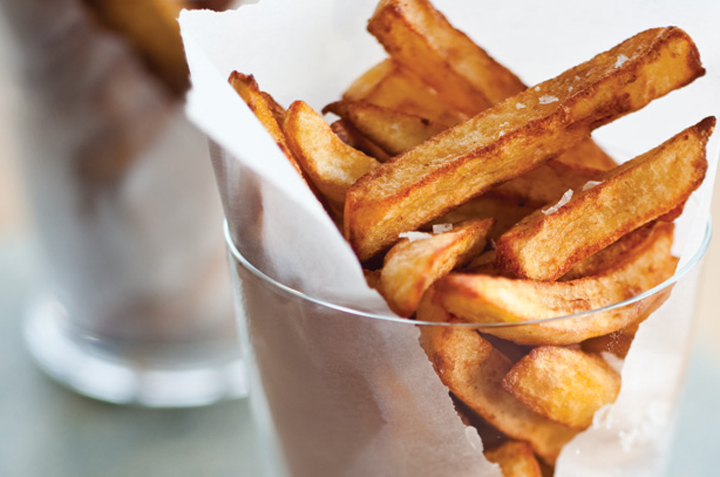The perfect potato
Russet potatoes (also called Idaho) contain more starch than other potatoes. Starch particles absorb less fat, cook faster and produce lighter and crispier fries.
Moisture inside a potato is pushed outward when it comes into contact with hot oil. This is the source of that bubbling sound you hear when fries are being cooked. Steam causes two very important things to happen. It discharges a lot of moisture from inside the potato and prevents it from absorbing too much oil. Oil cannot penetrate a potato while steam is being released.
Potatoes with low starch content and high moisture change colour before losing their moisture. The end result will be soft, mushy fries, due to steam trapped beneath the surface.
A popular belief is that old potatoes make good fries. This is not true. They contain less moisture and starch, which is what you want to make good fries.
The cut
A potato can be peeled or not, it’s up to you. What’s important is how it is cut. Fries should be about the same size in order to fry evenly. The thinner the cut, the faster and crispier the end result.
The soak
Soaking is essential. This removes excess starch, which will convert into sugar and brown fries before they are cooked. Some purists recommend three or four hours of soaking at room temperature. They advocate changing the water a few times during this period and making sure to remove starch at the bottom of the bowl from the previous soak. Recent tests have shown that 10 minutes of soaking is enough if you use warm tap water. This is a great time saver. It is also important to thoroughly drain and pat potatoes dry to avoid excess steam from cooling the cooking oil.
The oil
It is important to select the right oil. The more oil you use, the hotter it will remain during cooking, allowing steam to exit each fry. Peanut oil has long been the oil of choice for fries. It is an excellent pick but some have turned to canola oil due to the wave of peanut allergies. However, canola oil can emit a bad smell at high temperatures. Olive oil is more expensive but does add an unparalleled taste. Use regular olive oil (and not extra virgin) because regular olive oil has a higher smoke point and therefore a higher heat capacity.
Cooking to perfection
The perfect fries need to be cooked twice. The first round cooks the potato while the second round browns it to perfection at a higher temperature.
Heat a large amount of oil to 180°C (350°F) and cook the potatoes for 5 minutes. Remove them and transfer to a colander.
The second round of cooking begins at least 10 minutes later. Before you start, increase the temperature of the oil to 190°C (375°F) and then cook the fries until they are evenly browned. This second round can take place hours later, just before it’s time to serve.
After the fries are cooked, drain off excess oil and pat them dry with paper towel.
Recovering the oil
French fry cooking oil can be reused, up to seven or eight times for some deep fryer models. You should strain the oil through a coffee filter or through paper towels placed in a colander. Store the oil in a bottle that is well washed and dried (1-litre pop bottles are ideal) and refrigerate until the next use.
Tip
To bring out the sweet flavour of fries, add a drop of vanilla to the oil during deep-frying.
The secret to perfect fries
- Use Russet potatoes (Idaho).
- Soak cut potato slices in warm water for 10 minutes, dry thoroughly.
- Fry twice in the deep fryer.

